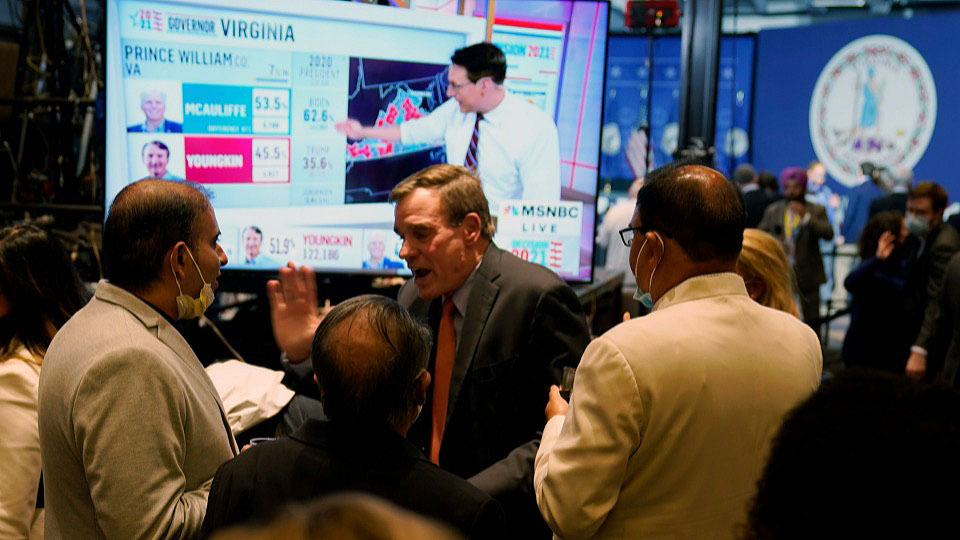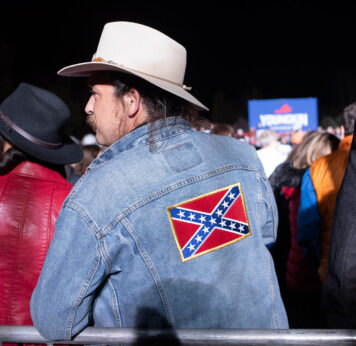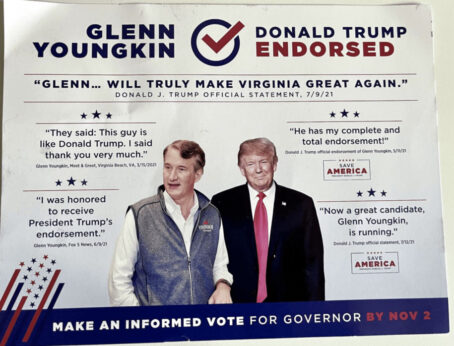
On Nov. 2, Virginia and New Jersey had important state elections. In the case of Virginia, the elections were for a new governor, lieutenant governor, and state attorney general, and for all 100 seats in the House of Delegates, the lower house of the state legislature, or General Assembly.
Under Virginia law, an incumbent governor cannot run for re-election, so the present Democratic Party governor, Ralph Northam, was excluded from the race. Lt. Gov. Justin Fairfax, also a Democrat, decided to run for governor. The Democratic attorney general, Mark Herring, opted to try for re-election.
The House of Delegates went into the election with a majority of 55 Democrats to 45 Republicans. So all three executive positions and the majority of both houses of the General Assembly were held by Democrats. This was the high point of a growing Democratic Party ascendency in this once very conservative state. And in the 2020 presidential election, Virginia went for Biden with a substantial margin of votes over Trump. In 2020’s congressional election, the Democrats held on to all seven of their Virginia congressional seats, while the Republicans held all of their four seats.
Within the Democratic Party, there was some friction over some key goals. Although the abolition of Virginia’s death penalty was a major progressive achievement, only incremental advances were made in some other progressive goals. Once more, the effort to repeal Virginia’s “Right to Work” statute was stymied by the opposition not only of the Republicans but also of Gov. Northam and more conservative Democrats in the legislature. Criminal justice and police reform also stalled due to the alignment of the same forces. So the situation was set up for some conflict within the Democratic Party’s ranks in this year’s elections. Yet earlier in 2021, it looked as if the Democrats would retain what they had and perhaps make more electoral advances.
At the outset, the Republican Party appeared to be in disarray. The Trumpite assault on the more traditional Republican Leadership led to a situation wherein primaries were replaced by caucuses. This stymied the gubernatorial aspirations of the most flamingly Trumpite candidate, State Sen. Amanda Chase. In the end, the Republicans named former Carlyle Group mogul Glenn Youngkin for governor, Jamaican-American Evangelical Christian Winsome Sears for lieutenant governor, and right-wing Cuban-American “law-and-order” hardliner Jason Miyares for state attorney general.
On the Democratic side, the first to announce for governor was progressive African-American delegate Jennifer Carrol Foy, who resigned her legislative seat in order to run. Incumbent Virginia Lt. Gov. Justin Fairfax, also African American, decided to run too, as did Jennifer McClellan, a more centrist African-American state senator from Southern Virginia. And the most left-wing member of the Virginia General Assembly, socialist Lee Carter, decided to run for governor while at the same time trying to retain his seat in the House of Delegates. But the hearts of the supporters of all three of these candidates sank when ex-governor Terry McAuliffe threw his hat into the ring, too. McAuliffe’s name recognition (plus major campaign support from funders and big-name endorsers) clinched the McAuliffe victory in the June 15 Democratic Primary, with Carroll Foy coming in a distant second, while McClellan, Fairfax, and Carter were further behind.
There was also a third-party candidate, Princess Blanding, who launched her candidacy to protest the lack of action by the major parties in dealing with police brutality. Her brother, Marcus-Davis Peters, was murdered by Richmond police in 2018, and she had participated in efforts to get strong police reform. A watered-down bill was passed, and to add insult to injury, was called the “Marcus” bill. At the signing ceremony, Blanding denounced the whole charade and thereafter decided to run for governor.
Through most of the ensuing months, it looked as if the Democrats would continue their willing streak in Virginia. But as election day neared, polls began to show Youngkin and the other Republican candidates closing the gap, and by Nov. 2, most polls showed a dead heat.

After the post-election dust settled, it turned out that the Democrats had suffered severe losses. Republican Youngkin defeated Democrat McAuliffe by 50.7% to 48.61% for governor (Blanding got 0.7%). For lieutenant governor, Republican Sears beat Democrat Ayala with numbers almost identical to those in the Youngkin-McAuliffe matchup, and for attorney general, Republican Miyares beat incumbent Democrat Herring 50.36% to 49.55%. Although the results of a couple of challenges in the House of Delegates races are not in yet, it appears the Democrats lost their majority there, too.
This setback set up the usual feeding frenzy of half-baked “interpretations” by various politicians and pundits. Many voices blamed the progressive wing of the Democratic Party for the results, for being too leftist. The names of right-wing Sens. Kyrsten Sinema, D-Ariz., and Joe Manchin, D-W.Va., were invoked as the kind of politicians the Democrats should support if they ever want to win an election again. Black Lives Matter got blamed for supposedly causing racial division, and so forth.
But there was something off-key about this chorus of howls of woe.
First of all, the margins by which the Republicans won were razor thin, as the reader can see by the statistics cited above. Secondly, most of the “progressive” Democratic delegates won their seats again, and at least one outstanding new one was added.
The main explanation for the Republican advance lies in a very high turnout from the most conservative white and rural areas of the state, compared to similar off-year elections in the past (by off-year is meant that there was no federal election to jazz things up in 2021). These are voters who, for whatever reason, like Donald J. Trump very much. The weaponization of school board controversies and discontent with vaccines and face masks was a key tactic in Republican agitation, and it bore fruit.
The Republican candidate for governor, Youngkin, tried to appeal to the Trumpite extremist base while also trying to behave like a responsible statesman toward voters in the suburbs.
And what did the Democrats do? They heavily emphasized a “Youngkin equals Trump” campaign strategy and talked very little about what actual policies McAuliffe would enact as governor. One could find McAuliffe’s actual policy plans if one looked hard enough online, but the average voter statewide only heard the message that Youngkin had been endorsed by Trump, coming both from the Trump promotors and from the Democrats!
A large percentage of the vote for Youngkin came from counties which include many very poor white households, which are suffering from scarce jobs, low pay, and lack of services, such as health care. The Democrats did not really try to challenge the idea among such rural and small-town white workers that Trump and the Republicans are their true friends; instead, they wrote them off completely. They did not effectively challenge the racist and other backward ideas which are such a big part of the mix in those communities (even in Appalachia, by the way, most of the cities voted for McAuliffe).

One of the most revealing pieces of McAuliffe campaign literature illustrates this mistake. The Democratic Party repeated announcements that Trump had endorsed Youngkin very likely served to bring out droves of Trump followers to vote for the latter. So clumsy was this tactic that many people seeing the piece probably thought it was Republican campaign literature. The idea was to shock Trump’s detractors into voting for McAuliffe, but it is likely this backfired.
In addition, through several campaign cycles, it appears that the Virginia Democratic Party has forgotten to have a “ground game.” The emphasis is often on raising money from well-off individuals and corporate supporters so that expensive television and online advertising can be paid for, instead of canvassing and shoe leather. This marginalizes blue-collar and especially lower-income voters, who have nobody to explain their concerns to in the campaign context.
Whether the Democrats can learn from this mistake will soon be seen, in the context of the 2022 midterm federal elections. Will they continue to scapegoat progressives and marginalize eloquent voices for justice like those of Princess Blanding?
At any rate, for the left, the lesson is clear: Don’t rely on the wisdom of the Democratic Party leadership to defend working-class interests; get out there and organize, in every workplace and in every community, and build the base for a far better politics than either of the bourgeois parties currently offers.
MORE ON THE VIRGINIA ELECTIONS AND THEIR IMPORTANCE FOR 2022:
> Democrats can avoid midterm election disaster by running on their actual agenda
> Things Youngkin didn’t mention about the history of education in Virginia
> Election 2021: Republicans make some major gains but not everywhere












Comments